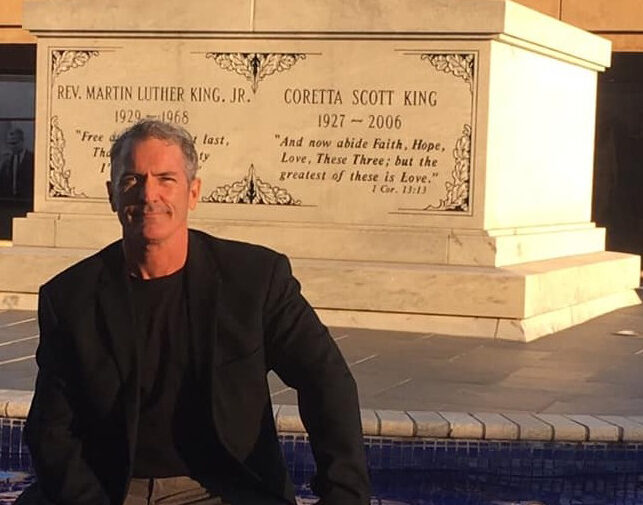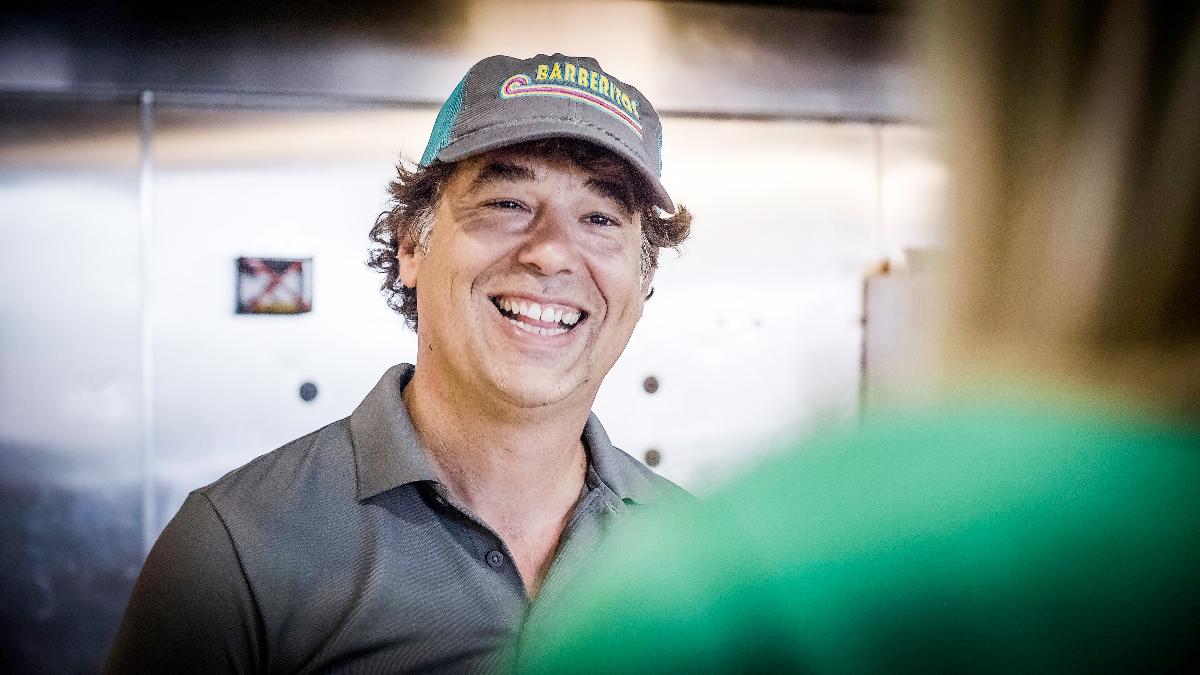
A small town in the Southeastern portion of The United States, so much art and culture has emerged from this region. Pulaski Street, an artery of Broad Street running the length of the city, conveys the traveler from university precincts to the hinterlands, from the bustle of downtown to a quiet, almost bucolic neighborhood.
Stan Mullins, an artist who lives and works in his studio situated near where Pulaski terminates at Cleveland Avenue, remembers when life along this thoroughfare was scrappier.
Early in Life, Mullins set out to become an artist. Even before knowing that the term existed, “Art” became his life’s calling. Born in Cherry Point, North Carolina, his Marine Corps Father was transferred to Washington DC and it was In Alexandria, Va. that Mullins spent his formative years, as artist and person. A cherished memory is riding the Metro to the Corcoran Museum of Art at age 11, with all the other Diplomats, Service men and Women, Politicians and Public servants, but young Mullins was going to draw pictures on a scholarship program. Upon retirement from The Corps, the family moved further south to Georgia. From here it was a short step to Athens and The University of Georgia. As an undergrad majoring in Fine Arts, Mullins first stumbled across the kudzu encased Cotton Seed Oil refinery building. It was then that Mullins knew he found his “Place.”
It took a few years and Italy looms large in the process, but Mullins ultimately purchased the studio summer of 1990. From his “Place” he began working on the extensive projects, locally, regionally and internationally. The CNN coverage in ‘92 set his artistic trajectory world wide. His Rwanda art expedition continues and his works there immediately preceding the 1994 Genocide have become a part of history. With the arrival of the 1996 Olympic Games to Atlanta and Georgia, Mullins set out on an Epic Mural, celebrating Athens, Georgia’s contributions.
Newly Married, and at a zenith of creativity, it was time to step beyond, so New York City became the next Chapter. Renting the house and bolstering the studio for months of being away at a time, Mullins set up a dual relationship. Arriving in New York just before the New Year 1997…fully diving in.
Thanks to a network of fellow artists and friends built over a lifetime, Mullins got a few key gigs right away…this led to permanent employment at one of the top Art Galleries still today; Pace Wildenstein MacGill. While working in the gallery world of upper echelon artists such as Jim Dine, Chuck Close, Di Corcia, Rauchenbach, Riger, Wegman, and countless other photographers and painters, Mullins pursued his own artistic career down in Soho and Jersey City.
By February of ‘97, Mullins was working on a major commission, “The Bread of Life” ceiling painting in the New Era Building on Broadway…and he landed a nice photo and byline in the New York Times.
Mullins first solo exhibitions debuted in April of 1997…The New Era Building on Broadway, Soho NYC, and Jersey City Gallery. Both critically acclaimed.
A key encounter with artist Peter Beard, as he was installing his retrospective in Soho, forged new pathways of thought.
Conversation and red carpet opening with Beard, led Mullins to new epiphanies: Art and Time.
Leaving the securement of paid employment, Mullins became one of an elite team of Artists that created at the time, the largest mural in the world, “Jersey City Columbus Avenue”, among many of his contributions, the Ellis Island building and the Locomotive standout.
One element remained that Mullins recalls wanting to secure and achieve in his goal of working and understanding the International Art world from the inner workings…the Museum of Modern Art.
The last building block came with employment within the Membership and Development team at MoMA.
Achieving all that he set out to do in New York City, all the while maintaining a relationship, working capital and creating works of art, as well as traveling back every so often for maintenance and upkeep of his studio in Athens, Ga. Mullins came to understand the next key element of Creativity: “Time.”
“Reflecting on the countless conversations, personal interactions with other highly successful artists as well as the daily experience of New York City, the realization dawned; I have achieved what I set out to do.” Mullins stated.
In the spring of 2000, with a solo exhibition lined up for the Fall in Belenky Gallery on Wooster Street in Soho, Mullins came home to create.
From the kudzu entwined late 1980’s, times have changed on Pulaski Street. The refurbished Leathers Building across the street houses a yoga studio, a wine shop, and an excellent BBQ joint. The angular profiles of modernist homes now punctuate a quiet, leafy neighborhood thrumming with prosperity.
Mullins greets me with enthusiasm, sliding back a gate stamped with his name. A statue of Apollo looks down mutely from brick frontage. Paving stones guide us to a koi pond fed by a gentle, trickling cascade. Constructing this oasis in the middle of the city has taken decades of work, salvaging beauty from the detritus of neglected property.
Looming in the background is the nucleus of the property, a converted cottonseed oil warehouse that serves as his capacious studio space. This vaulted tin and iron structure and the lawn sprawling out behind it have become the sites of a quiet revolution, where Mullins is fashioning a life and a body of work that challenges the dominant paradigm of artistic success. He’s piloting a disruptive startup, one that positions the artist as an entrepreneur and trades in a very different kind of currency than the art world recognizes. The path Mullins is carving represents a stark alternative to the way we see the artist in the contemporary world.
Fine art is a business that profits by concealing its infrastructure, commodifying authenticity, and restricting admission. At the pinnacle of “success” stand contemporary artists whose names fetch millions at galleries and auction houses: Koons, Prince, Hirst, Murakami, and so on. Their work attracts buyers not only for its aesthetic merit but also for its market performance. Caveats apply, but investing in the right kind of art reaps lucrative dividends.
As with any commodity, perception of value is what drives pricing. Dropping millions of dollars on a Hockney original or a Warhol print only makes sense if it’s likely to appreciate over time. What makes this artwork valuable is the buzz swirling around the artist, the aura of genius, and the scarcity of available supply.
Stakeholders in this venture carefully manage this celebrity branding. A constellation of critics and auction houses function as gatekeepers, policing the boundaries of what qualifies as fine art and what’s not. The price of entrance varies, but usually includes training in elite art schools, gallery representation, solo shows in New York or Los Angeles, reviews in the right organs of criticism, and finally entrance into museums and auction houses.
Earlier in life, Mullins dutifully followed this prescribed path. As an eleven year-old in the Washington D.C. suburbs, he earned a scholarship to the prestigious Corcoran School of the Arts and Design. He was a skateboarding punk riding the Metro with the stodgy suits heading toward the Capitol. He’d marvel at all the monumental art surrounding him, then get off at his stop and go draw pictures all day. He became determined to make it as an artist.
Now it is Sculptures that loom Large in his work. From his Pulaski Street studio, Mullins has ventured to Carrara, Italy as well as Elberton, Georgia, each a haven of stone; Marble and Granite. He exchanged the concrete jungles of New York for the marble quarries of Carrara. As a sculptor, it connected him with the region that had supplied Michelangelo with his materials and steeped him in the storied craft of Italian artisans. Mullins began to appreciate a different currency in art: the time that allowed for the creation of timeless art.
When coming to Athens in the 1980’s, Mullins was venturing into new territory. The Classic City was renowned for its music scene, but not its fine arts. There wasn’t a thriving gallery scene or teeming hordes of buyers and critics.
What there was in Athens mattered more to Mullins: a vibrant art scene, tranquility, and nearby quarries in Elberton, the granite capital of the world. From the decaying ruins of the cottonseed oil factory, he began to form an imaginative new world. His yard filled with sculptures. Buyers from around the world commissioned work from him.
In the solitude of his Pulaski Street studio, he began asking himself what’s become a consuming question. It’s one he repeats while twilight descends: “What is value?”
The rhythmic drone of cicadas revives as Stan Mullins reveals the answer he’s found. It’s time — both in the sense of freedom to create on one’s own terms and in the integrity that artistic production under these conditions carries across generations.
Mullins uses traditional techniques to cast classical subjects in monumental clay, stone, and bronze. He doesn’t employ 3-D printers or a corps of assistants to execute his artistic vision. He’s not making brazen political statements or commenting ironically on art history in an age of mass kitsch. His work is as likely to show up in public spaces as in galleries or private collections.
That’s not to say he’s a nostalgist embalming the past. Take the bronze bust of Pandora Mullins recently fashioned, for example. The legend is familiar: Pandora opens a forbidden jar, releasing all the evils that stalk the world. It’s a myth designed to explain lost innocence and account for suffering that marks our world. But Mullins makes it a parable for the Information Age and the temptations of curiosity. He installed a halo of lights ‘inside’ his Pandora. Crucially, there’s no jar or box near the bust. Instead, he exposed the empty interior of the cast bronze. Evil originates not from without, but from within us, he suggests. In the hands of a master sculptor, classical myth speaks unsettling truths to the present.
What Mullins is doing is creating enduring value from the raw materials of stone and marble for broader public consumption. He likes to work with the character of the sections he’s quarried, not impose some inflexible grid on them. He’s a master, not a machine. Putting it differently, he does the work of several machines, in ways they could never replicate. That stamps his work with authenticity. It creates a lasting currency in monuments that will outlast ephemeral trends and momentary fashions. “A thing of beauty is a joy forever,” opined Keats, and that’s precisely the long game Mullins is playing.
Our culture venerates entrepreneurs. Why? They disrupt conventions. They have the imagination and courage to create worlds that didn’t exist before. Most of all, they have the cachet of controlling their own destinies. We long to wield that power over our own lives. That’s why we project our aspirations on Steve Jobs, Elon Musk, Jay Z, and Oprah Winfrey.
Maybe we ought to think the same way about artists like Stan Mullins. He’s rewriting the playbook of how to make it in the art market. He’s redefining value in an unlikely place. And he’s creating a corpus of work that recasts classical themes in ways that speak to the present moment, yet will endure. In pursuing this, he represents a kind of archetype for artists struggling to make it on their own terms outside the system.
It’s something to consider as I travel along the length of Pulaski back into the restless energy of downtown Athens.




